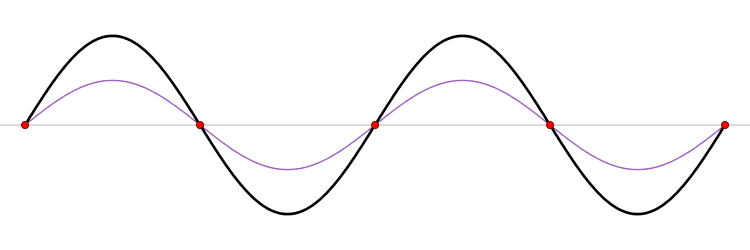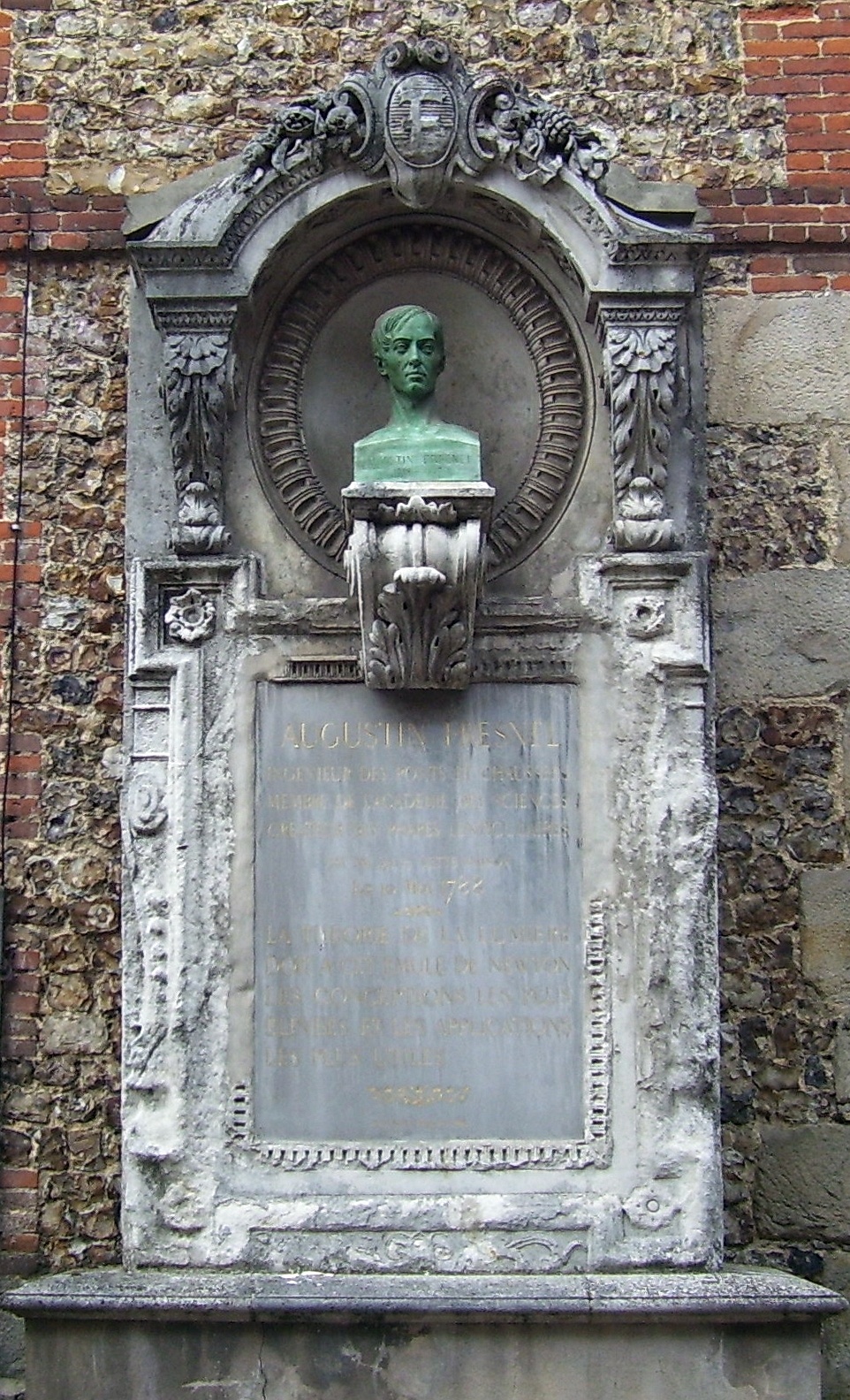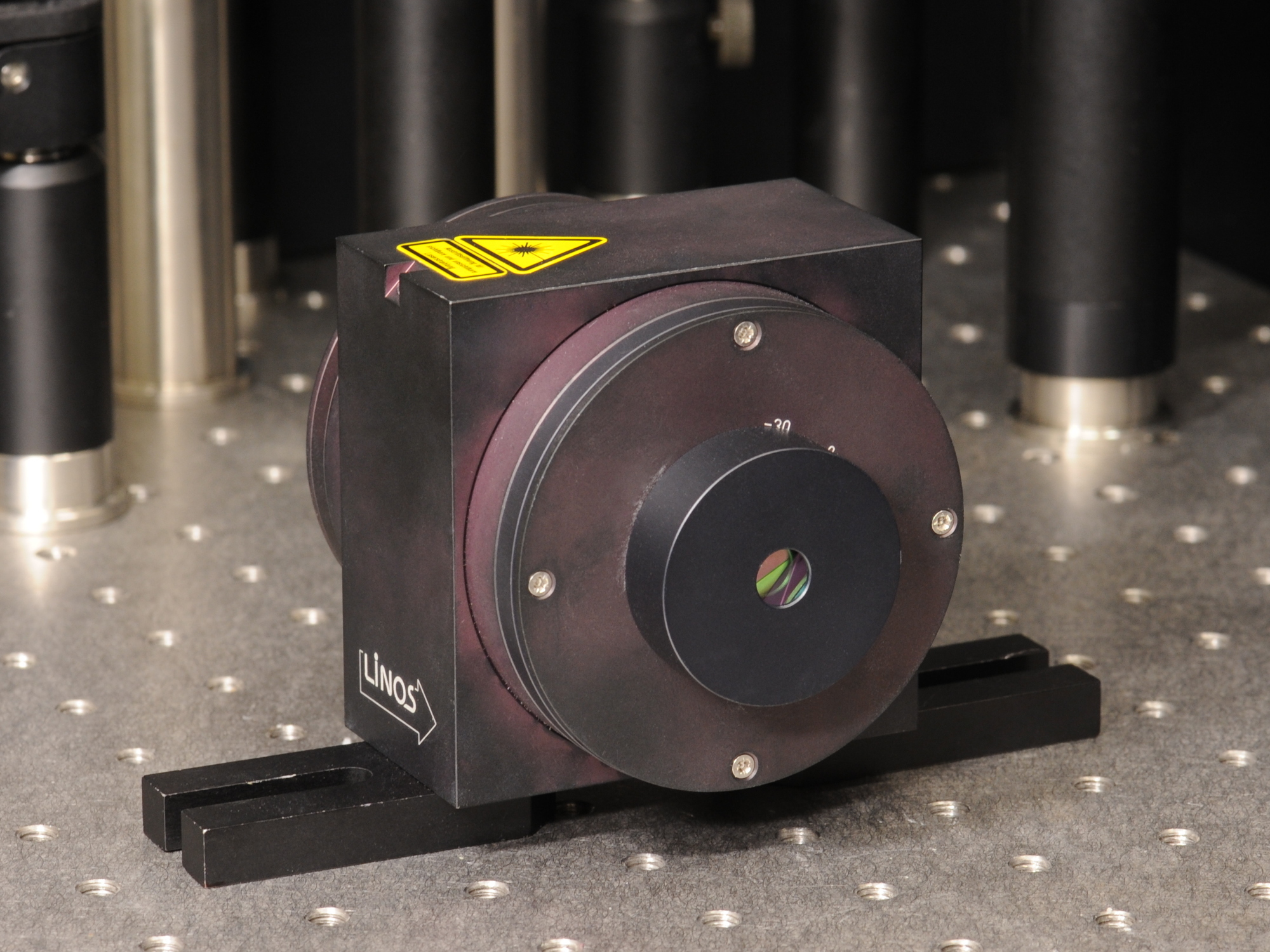|
Faraday Effect
The Faraday effect or Faraday rotation, sometimes referred to as the magneto-optic Faraday effect (MOFE), is a physical magneto-optical phenomenon. The Faraday effect causes a polarization rotation which is proportional to the projection of the magnetic field along the direction of the light propagation. Formally, it is a special case of gyroelectromagnetism obtained when the dielectric permittivity tensor is diagonal. This effect occurs in most optically transparent dielectric materials (including liquids) under the influence of magnetic fields. Discovered by Michael Faraday in 1845, the Faraday effect was the first experimental evidence that light and electromagnetism are related. The theoretical basis of electromagnetic radiation (which includes visible light) was completed by James Clerk Maxwell in the 1860s. Maxwell's equations were rewritten in their current form in the 1870s by Oliver Heaviside. The Faraday effect is caused by left and right circularly polarized wav ... [...More Info...] [...Related Items...] OR: [Wikipedia] [Google] [Baidu] |
Physics
Physics is the natural science that studies matter, its fundamental constituents, its motion and behavior through space and time, and the related entities of energy and force. "Physical science is that department of knowledge which relates to the order of nature, or, in other words, to the regular succession of events." Physics is one of the most fundamental scientific disciplines, with its main goal being to understand how the universe behaves. "Physics is one of the most fundamental of the sciences. Scientists of all disciplines use the ideas of physics, including chemists who study the structure of molecules, paleontologists who try to reconstruct how dinosaurs walked, and climatologists who study how human activities affect the atmosphere and oceans. Physics is also the foundation of all engineering and technology. No engineer could design a flat-screen TV, an interplanetary spacecraft, or even a better mousetrap without first understanding the basic laws of physics ... [...More Info...] [...Related Items...] OR: [Wikipedia] [Google] [Baidu] |
Superposition Principle
The superposition principle, also known as superposition property, states that, for all linear systems, the net response caused by two or more stimuli is the sum of the responses that would have been caused by each stimulus individually. So that if input ''A'' produces response ''X'' and input ''B'' produces response ''Y'' then input (''A'' + ''B'') produces response (''X'' + ''Y''). A function F(x) that satisfies the superposition principle is called a linear function. Superposition can be defined by two simpler properties: additivity F(x_1+x_2)=F(x_1)+F(x_2) \, and homogeneity F(a x)=a F(x) \, for scalar . This principle has many applications in physics and engineering because many physical systems can be modeled as linear systems. For example, a beam can be modeled as a linear system where the input stimulus is the load on the beam and the output response is the deflection of the beam. The importance of linear systems is that they are easier to analyze mathematical ... [...More Info...] [...Related Items...] OR: [Wikipedia] [Google] [Baidu] |
Circular Polarization
In electrodynamics, circular polarization of an electromagnetic wave is a polarization state in which, at each point, the electromagnetic field of the wave has a constant magnitude and is rotating at a constant rate in a plane perpendicular to the direction of the wave. In electrodynamics, the strength and direction of an electric field is defined by its electric field vector. In the case of a circularly polarized wave, as seen in the accompanying animation, the tip of the electric field vector, at a given point in space, relates to the phase of the light as it travels through time and space. At any instant of time, the electric field vector of the wave indicates a point on a helix oriented along the direction of propagation. A circularly polarized wave can rotate in one of two possible senses: clockwise or ''right-handed circular polarization (RHCP)'' in which the electric field vector rotates in a right-hand sense with respect to the direction of propagation, and counter-clockw ... [...More Info...] [...Related Items...] OR: [Wikipedia] [Google] [Baidu] |
Superposition Principle
The superposition principle, also known as superposition property, states that, for all linear systems, the net response caused by two or more stimuli is the sum of the responses that would have been caused by each stimulus individually. So that if input ''A'' produces response ''X'' and input ''B'' produces response ''Y'' then input (''A'' + ''B'') produces response (''X'' + ''Y''). A function F(x) that satisfies the superposition principle is called a linear function. Superposition can be defined by two simpler properties: additivity F(x_1+x_2)=F(x_1)+F(x_2) \, and homogeneity F(a x)=a F(x) \, for scalar . This principle has many applications in physics and engineering because many physical systems can be modeled as linear systems. For example, a beam can be modeled as a linear system where the input stimulus is the load on the beam and the output response is the deflection of the beam. The importance of linear systems is that they are easier to analyze mathematical ... [...More Info...] [...Related Items...] OR: [Wikipedia] [Google] [Baidu] |
John Kerr (physicist)
John Kerr FRS (; 17 December 1824 – 15 August 1907) was a Scottish physicist and a pioneer in the field of electro-optics. He is best known for the discovery of what is now called the Kerr effect. Life and work John Kerr was born on 17 December 1824 at Ardrossan, Scotland. He was a student in Glasgow from 1841 to 1846, and at the Theological College of the Free Church of Scotland, in Edinburgh, in 1849. Starting in 1857 he was mathematical lecturer at the Free Church Training College in Glasgow. He died in Glasgow in 1907. Kerr's most important experimental work was the discovery of double refraction in solid and liquid dielectrics in an electrostatic field (1875) which is now known as Kerr effect. In the Kerr effect, difference between refractive index experienced by ordinary and extraordinary ray is proportional to the square of the electric field. Where the relationship is linear, the effect is known as the Pockels effect. Intense light from lasers allows the achievemen ... [...More Info...] [...Related Items...] OR: [Wikipedia] [Google] [Baidu] |
Electro-optic Effect
Electro–optics is a branch of electrical engineering, electronic engineering, materials science, and material physics involving components, electronic devices such as lasers, laser diodes, LEDs, waveguides, etc. which operate by the propagation and interaction of light with various tailored materials. It is closely related to the branch of optics, involving application of generation of photons, called photonics. It is not only concerned with the " electro–optic effect", since it deals with the interaction between the electromagnetic (optical) and the electrical ( electronic) states of materials. Electro-optical devices The electro-optic effect is a change in the optical properties of an optically active material due to interaction with light. This interaction usually results in a change in the birefringence, and not simply the refractive index of the medium. In a Kerr cell, the change in birefringence is proportional to the square of the optical electric field, and t ... [...More Info...] [...Related Items...] OR: [Wikipedia] [Google] [Baidu] |
Étienne-Louis Malus
Étienne-Louis Malus (; ; 23 July 1775 – 23 February 1812) was a French officer, engineer, physicist, and mathematician. Malus was born in Paris, France. He participated in Napoleon's expedition into Egypt (1798 to 1801) and was a member of the mathematics section of the Institut d'Égypte. Malus became a member of the Académie des Sciences in 1810. In 1810 the Royal Society of London awarded him the Rumford Medal. His mathematical work was almost entirely concerned with the study of light. He studied geometric systems called ''ray systems'', closely connected to Julius Plücker's '' line geometry''. He conducted experiments to verify Christiaan Huygens's theories of light and rewrote the theory in analytical form. His discovery of the polarization of light by reflection was published in 1809 and his theory of double refraction of light in crystals, in 1810. Malus attempted to identify the relationship between the polarising angle of reflection that he had discovered, an ... [...More Info...] [...Related Items...] OR: [Wikipedia] [Google] [Baidu] |
Augustin-Jean Fresnel
Augustin-Jean Fresnel (10 May 1788 – 14 July 1827) was a French civil engineer and physicist whose research in optics led to the almost unanimous acceptance of the wave theory of light, excluding any remnant of Newton's corpuscular theory, from the late 1830s until the end of the 19th century. He is perhaps better known for inventing the catadioptric (reflective/refractive) Fresnel lens and for pioneering the use of "stepped" lenses to extend the visibility of lighthouses, saving countless lives at sea. The simpler dioptric (purely refractive) stepped lens, first proposed by Count Buffon and independently reinvented by Fresnel, is used in screen magnifiers and in condenser lenses for overhead projectors. By expressing Huygens's principle of secondary waves and Young's principle of interference in quantitative terms, and supposing that simple colors consist of sinusoidal waves, Fresnel gave the first satisfactory explanation of diffraction by straight edges, including t ... [...More Info...] [...Related Items...] OR: [Wikipedia] [Google] [Baidu] |
Faraday Photograph Ii
Michael Faraday (; 22 September 1791 – 25 August 1867) was an English scientist who contributed to the study of electromagnetism and electrochemistry. His main discoveries include the principles underlying electromagnetic induction, diamagnetism and electrolysis. Although Faraday received little formal education, he was one of the most influential scientists in history. It was by his research on the magnetic field around a conductor carrying a direct current that Faraday established the concept of the electromagnetic field in physics. Faraday also established that magnetism could affect rays of light and that there was an underlying relationship between the two phenomena.. the 1911 Encyclopædia Britannica. He similarly discovered the principles of electromagnetic induction, diamagnetism, and the laws of electrolysis. His inventions of electromagnetic rotary devices formed the foundation of electric motor technology, and it was largely due to his efforts that elect ... [...More Info...] [...Related Items...] OR: [Wikipedia] [Google] [Baidu] |
Optical Circulators
An optical circulator is a three- or four-port optical device designed such that light entering any port exits from the next. This means that if light enters port 1 it is emitted from port 2, but if some of the emitted light is reflected back to the circulator, it does not come out of port 1 but instead exits from port 3. This is analogous to the operation of an electronic circulator. Fiber-optic circulators are used to separate optical signals that travel in opposite directions in an optical fiber, for example to achieve bi-directional transmission over a single fiber. Because of their high isolation of the input and reflected optical powers and their low insertion loss, optical circulators are widely used in advanced communication systems and fiber-optic sensor applications. Optical circulators are ''non-reciprocal'' optics, which means that changes in the properties of light passing through the device are not reversed when the light passes through in the opposite direction. T ... [...More Info...] [...Related Items...] OR: [Wikipedia] [Google] [Baidu] |
Optical Isolator
An optical isolator, or optical diode, is an optical component which allows the transmission of light in only one direction. It is typically used to prevent unwanted feedback into an optical oscillator, such as a laser cavity. The operation of ome ofthe devices depends on the Faraday effect (which in turn is produced by magneto-optic effect), which is used in the main component, the Faraday rotator. Theory The main component of the optical isolator is the Faraday rotator. The magnetic field, B, applied to the Faraday rotator causes a rotation in the polarization of the light due to the Faraday effect. The angle of rotation, \beta, is given by, :\beta=\nu B d\,, where, \nu is the Verdet constant of the material (amorphous or crystalline solid, or liquid, or crystalline liquid, or vaprous, or gaseous) of which the rotator is made, and d is the length of the rotator. This is shown in Figure 2. Specifically for an optical isolator, the values are chosen to give a rotation of ... [...More Info...] [...Related Items...] OR: [Wikipedia] [Google] [Baidu] |
Faraday Rotator
A Faraday rotator is a polarization rotator based on the Faraday effect, a magneto-optic effect involving transmission of light through a material when a longitudinal static magnetic field is present. The state of polarization (such as the axis of linear polarization or the orientation of elliptical polarization) is rotated as the wave traverses the device, which is explained by a slight difference in the phase velocity between the left and right circular polarizations. Thus it is an example of ''circular birefringence'', as is optical activity, but involves a material only having this property in the presence of a magnetic field. Circular birefringence, involving a difference in propagation between opposite ''circular'' polarizations, is distinct from ''linear birefringence'' (or simply birefringence, when the term is not further specified) which also transforms a wave's polarization but not through a simple rotation. The polarization state is rotated in proportion to the appl ... [...More Info...] [...Related Items...] OR: [Wikipedia] [Google] [Baidu] |





